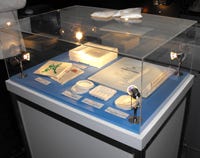High-voltage molding innovations coming from Japan
November 24, 2008
|
It’s tough to figure out where to begin, trying to tell you guys about some of the brand-new all-electric Japanese iron I saw on show at the International Plastics Fair 2008 www.a-tec.com.jp/plastics exposition at the Makuhari Messe (Nov. 7–11). How’s this for starters, though: In addition to a new 100-ton model in its SE-DUZ Series that was molding ultrathin-wall PC light guide panels at 4-second cycles and at injection speeds up to 1000 mm/sec (without accumulators—it’s servomotored), Sumitomo had this 10-ton prototype running called the ML200. It was equipped with a new type of injection system engineered to provide fixed-quantity feeding to eliminate shear. It also had a clamping unit powered by—get this—a superprecision linear electromagnetic drive system.
A company source told us the drive system provides “smooth, stress-free” open and close and platen parallelism that’s close to zero! The major market Sumitomo’s targeted for this puppy is lens molding. It was micromolding PC pickup blue-ray lenses at the show, a 0.70g shot at 500 mm/sec in 16-second cycles.
Oh, and turning back to an all-electric capable of achieving a 1000-mm/sec maximum injection speed, Fanuc had one, too—its 100-ton Roboshot S-2000i:100 BH—molding 0.25-mm-thin light guide panels for mobile phones in a two-cavity mold out of a high-flow PC. Its high-power shooter’s servomotor is designed to deliver a sort of two-stage injection sequence—a somewhat slow start, and then what a company source called “a canon shot.” And, speaking of high speed, how about this: high-speed, thin-wall molding on an all-electric.
On its new 150-ton S-2000i:150B with 560-by-410 mm between the bars, it ran PP parts with 0.25-mm walls at a 3.8-second clip and drawing less than 11 kWh. Key to its speed was Fanuc’s overlapped cycle sequences. The machine was equipped with an advanced mold protection system monitoring motor current and load that can stop the clamp on a dime during either the mold close, or open sequence if its A-I control senses it’s out of range.
OK—just one more, then I have to take a nap (jet-lag, dig?). In addition to molding automotive fuel tank couplings in two-cavity tooling out of “Voltiga,” a next-generation composite loaded with carbon nanotube reinforcements, Nissei proved it can keep it “green” by running lids out of a compostable material compounded inline from pulp, starch, and water.
On a 110-ton, all-electric NEX110-18EPI equipped with a short, specially engineered, low-compression screw cylinder, a cooling blower for the injection cylinder, and a materials mixing unit, Nissei ran pulp parts using a special coining sequence. In addition to reducing our environmental footprint, Nissei’s new pulp injection molding system gives new meaning to the “PIM” acronym.—[email protected].
About the Author(s)
You May Also Like








